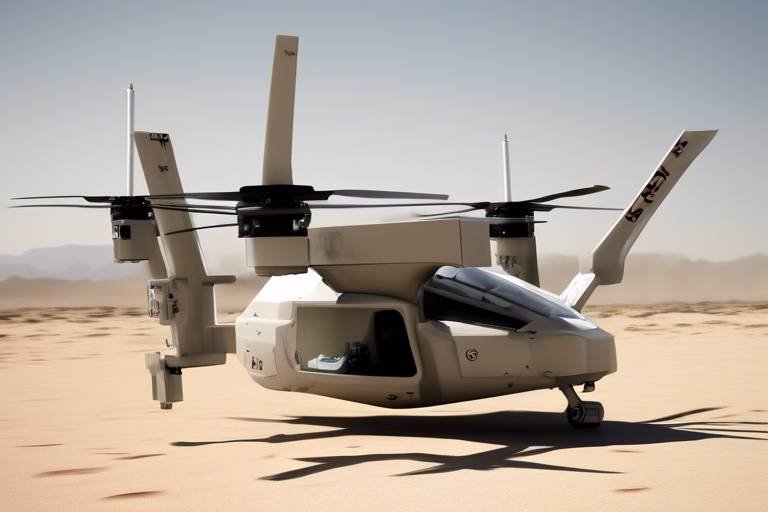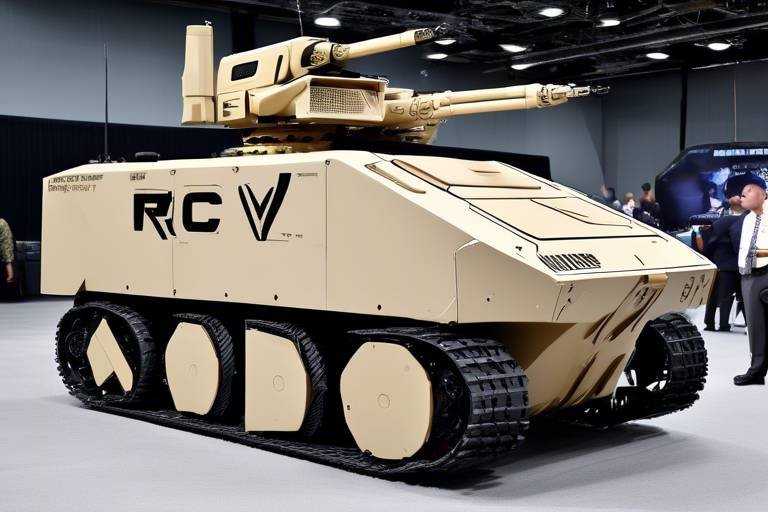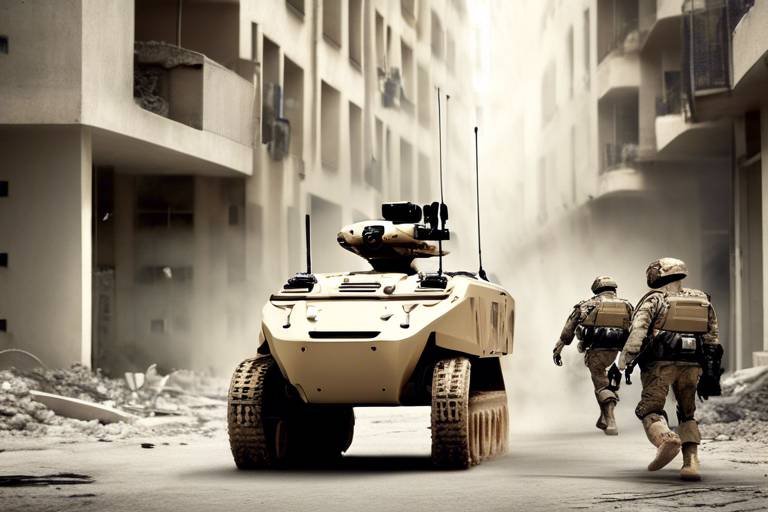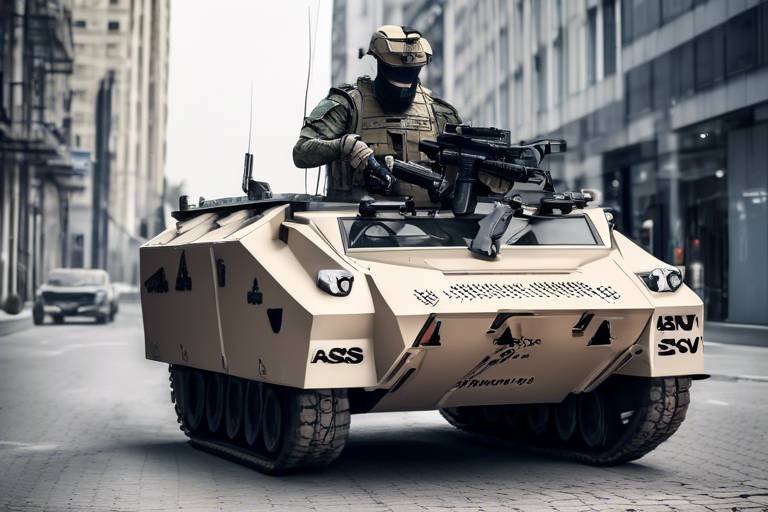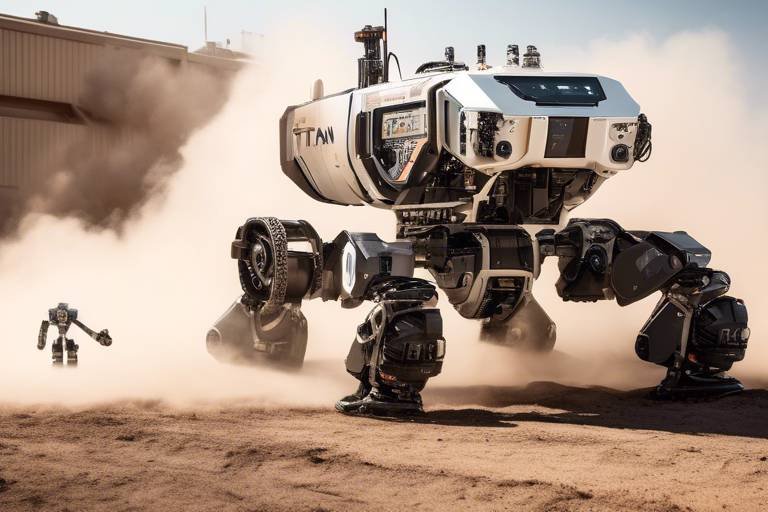The Use of the K-MAX in Unmanned Resupply Missions
The K-MAX helicopter is truly a game-changer in the realm of unmanned resupply missions. Imagine a flying machine that can lift heavy loads without the need for a pilot on board—this is what the K-MAX offers. With its unique design and advanced technology, it not only enhances logistical operations but also significantly reduces the risks associated with traditional resupply methods. In various operational environments, whether it's a military outpost in a remote area or a civilian disaster relief effort, the K-MAX stands out as a robust solution for delivering essential supplies. This article will delve into the innovative applications of the K-MAX, showcasing its capabilities, advantages, and the profound impact it has on logistics.
The K-MAX helicopter features a unique design that enables vertical takeoff and landing, making it ideal for resupply missions in challenging terrains. Its advanced technology enhances efficiency and reduces operational risks. The K-MAX employs a coaxial rotor system, which allows it to maintain stability and control even in adverse conditions. This design not only improves its payload capacity but also makes it more maneuverable in tight spaces, such as mountainous regions or densely populated urban areas. By utilizing advanced navigation and control systems, the K-MAX can autonomously execute complex missions, freeing operators from the need to be physically present in the field. This technological edge is what sets the K-MAX apart from traditional helicopters and other unmanned aerial vehicles (UAVs).
K-MAX provides significant operational advantages, including reduced manpower requirements and the ability to transport heavy loads. Imagine being able to deliver supplies to soldiers stationed in remote areas without putting any personnel at risk. This is a reality with the K-MAX. By minimizing the need for ground crews and pilots, operations can be conducted more efficiently and with fewer logistical complications. The helicopter's ability to carry substantial payloads—up to 6,000 pounds—means it can transport a wide variety of supplies, from food and water to ammunition and medical equipment. This versatility contributes to mission success in both military and civilian applications, making the K-MAX an invaluable asset in any logistical operation.
The K-MAX is capable of lifting substantial payloads, which is crucial for resupply missions. Its design allows for a maximum payload capacity of 6,000 pounds, making it one of the most capable unmanned helicopters in the market. This capability is particularly beneficial in scenarios where traditional vehicles may struggle, such as rugged terrains or areas with limited access. The K-MAX can be configured for various types of cargo, ensuring that it meets the demands of diverse logistical operations. Whether it’s delivering heavy equipment for construction projects or emergency supplies during natural disasters, the K-MAX can adapt to the mission at hand.
Understanding the specific payload capabilities of the K-MAX is essential. The helicopter can be equipped with various attachments to handle different types of cargo. Below is a summary of its specifications:
| Payload Type | Maximum Load (lbs) | Operational Range (miles) |
|---|---|---|
| General Cargo | 6,000 | 120 |
| Medical Supplies | 4,000 | 150 |
| Construction Materials | 5,500 | 100 |
When compared to other unmanned aerial vehicles, the K-MAX stands out due to its unique design and capabilities. Many drones may excel in agility or speed, but few can match the K-MAX's payload capacity and operational versatility. For instance, while smaller drones may be suitable for surveillance or light cargo, they often lack the ability to transport heavy loads over long distances. The K-MAX bridges this gap, offering a solution that is both powerful and adaptable. This comparative advantage makes it a preferred choice for organizations looking to enhance their logistical operations.
K-MAX has been deployed in various real-world scenarios, demonstrating its versatility. From military operations in Afghanistan to disaster relief efforts in Haiti, the K-MAX has proven its effectiveness in resupply missions. For example, during the aftermath of natural disasters, the K-MAX has been used to deliver food, water, and medical supplies to areas that are otherwise inaccessible due to damaged infrastructure. The helicopter's ability to operate autonomously allows for rapid response times, which is critical in emergency situations. The real-world applications of the K-MAX highlight its potential to revolutionize how we approach logistics in challenging environments.
Despite its advantages, the K-MAX faces certain challenges and limitations. One of the primary hurdles is the environmental factors that can significantly impact its performance. Weather conditions such as strong winds, rain, or fog can hinder its operational capabilities. Additionally, the helicopter's reliance on GPS and other navigation systems means that areas with poor satellite coverage may pose challenges for mission execution. Understanding these limitations is essential for effective mission planning.
Environmental conditions can significantly impact the performance of the K-MAX. For instance, flying in high winds can affect stability, while heavy rain might limit visibility and operational effectiveness. This subheading discusses how weather and terrain affect its operational capabilities and mission planning. Operators must consider these factors when scheduling missions to ensure the K-MAX can perform optimally.
Continuous advancements in technology are crucial for the K-MAX. As the field of unmanned aerial vehicles evolves, so too must the K-MAX. This section explores potential upgrades and innovations that could further enhance its performance in unmanned resupply missions. For example, integrating advanced sensors for obstacle detection and improved navigation systems could greatly enhance its operational capabilities in challenging environments.
- What is the maximum payload capacity of the K-MAX? The K-MAX can carry up to 6,000 pounds of cargo.
- How does the K-MAX navigate in challenging terrains? The K-MAX uses advanced navigation systems that allow for autonomous flight, even in rugged environments.
- What are some real-world applications of the K-MAX? The K-MAX has been used for military resupply missions and disaster relief operations, among others.
- What limitations does the K-MAX face? Environmental factors such as weather and terrain can impact its performance and mission planning.

Overview of K-MAX Technology
The K-MAX helicopter represents a significant leap in aviation technology, particularly in the realm of unmanned resupply missions. With its distinctive design, the K-MAX is specially engineered for vertical takeoff and landing (VTOL), making it a game-changer in challenging environments such as mountainous terrains or densely forested areas where traditional transport methods may falter. This helicopter is not just another unmanned aerial vehicle (UAV); it’s a highly specialized machine that combines efficiency and reliability in one robust package.
What sets the K-MAX apart is its capability to perform in various operational settings, from military deployments to humanitarian aid missions. Its advanced technology not only enhances its operational efficiency but also significantly reduces the risks typically associated with manned missions. Imagine a helicopter that can navigate through treacherous weather conditions and rugged landscapes without the need for a pilot on board. That’s the magic of the K-MAX!
The K-MAX is equipped with a suite of cutting-edge technologies that facilitate its unmanned operations. These include:
- Autonomous Flight Systems: The K-MAX can autonomously navigate to predetermined locations, which reduces the workload on operators and increases mission success rates.
- Advanced Payload Management: It features a sophisticated system for managing and securing payloads, ensuring that cargo is delivered safely and efficiently.
- Real-Time Data Transmission: The helicopter can transmit data back to the control center in real-time, providing critical updates on mission progress and environmental conditions.
Moreover, the K-MAX's design allows for easy maintenance and quick turnaround times, which are crucial in urgent operational scenarios. Its modular construction means that parts can be replaced or upgraded without extensive downtime, keeping it ready for action when it matters most.
In summary, the K-MAX helicopter is not just a tool; it’s a revolutionary platform that transforms the landscape of logistics and resupply missions. Its combination of advanced technology, operational flexibility, and robust design positions it as a leader in the field of unmanned aerial systems.
- What is the maximum payload capacity of the K-MAX? The K-MAX can lift payloads of up to 6,000 pounds, making it ideal for transporting heavy cargo.
- How does the K-MAX navigate without a pilot? The K-MAX utilizes advanced autonomous flight systems that allow it to follow pre-programmed flight paths and make real-time adjustments as needed.
- In what types of missions is the K-MAX typically used? The K-MAX is used in military operations, humanitarian aid missions, and disaster response scenarios, among others.
- What are the maintenance requirements for the K-MAX? The K-MAX features a modular design that simplifies maintenance, allowing for quick part replacements and minimal downtime.

Operational Advantages
The K-MAX helicopter is not just another piece of machinery; it’s a game-changer in the realm of unmanned resupply missions. Imagine a world where supply chains are streamlined, and logistics are handled with utmost efficiency—this is the reality that the K-MAX brings to the table. One of the most significant operational advantages of the K-MAX is its ability to operate with reduced manpower requirements. In military operations, where every second counts, having fewer personnel on the ground means less exposure to danger and more focus on mission objectives. This helicopter can autonomously navigate and deliver supplies, allowing human resources to be allocated to more critical tasks.
Moreover, the K-MAX is designed to transport heavy loads effortlessly. Think of it as the heavyweight champion of the skies, capable of lifting substantial payloads that are pivotal for resupply missions. This capability not only enhances operational efficiency but also ensures that troops or remote outposts receive the necessary supplies without delay. For instance, the K-MAX can carry loads up to 6,000 pounds, which is crucial for delivering food, medical supplies, and ammunition in challenging environments.
Another operational advantage is the versatility of the K-MAX. It can be deployed in various environments, whether it’s a battlefield, disaster-stricken area, or remote construction site. The helicopter’s vertical takeoff and landing (VTOL) capabilities allow it to access locations that are often unreachable by traditional vehicles. This adaptability is essential, especially when considering the unpredictable nature of operational environments. For example, during a natural disaster, the K-MAX can quickly deliver supplies to isolated communities, making it an invaluable asset in humanitarian missions.
To further illustrate the K-MAX's operational advantages, let’s take a look at a comparative table showcasing its capabilities against traditional resupply methods:
| Feature | K-MAX | Traditional Methods |
|---|---|---|
| Payload Capacity | Up to 6,000 lbs | Varies, typically less than 3,000 lbs |
| Manpower Requirement | Minimal | High |
| Operational Environment | All terrains | Limited to roads and accessible areas |
| Delivery Speed | Fast and efficient | Slower, dependent on ground vehicles |
In summary, the K-MAX helicopter revolutionizes the way we think about resupply missions. Its ability to function with reduced manpower, carry heavy loads, and operate in various environments makes it a vital tool for both military and civilian applications. With the K-MAX, the future of logistics is not just bright; it's soaring high above the clouds!
- What is the maximum payload capacity of the K-MAX? The K-MAX can carry loads of up to 6,000 pounds.
- How does the K-MAX improve mission efficiency? By reducing manpower requirements and enabling rapid delivery of supplies in challenging environments.
- Can the K-MAX operate in adverse weather conditions? Yes, the K-MAX is designed to handle various environmental factors, although extreme conditions may still pose challenges.
- What are the primary applications of the K-MAX? It is used in military resupply missions, humanitarian aid, and remote construction projects.

Enhanced Load Capacity
The K-MAX helicopter is a true marvel of engineering, particularly when it comes to its . Designed with a unique dual-rotor configuration, the K-MAX can lift and transport substantial payloads that many other drones simply cannot match. This capability is crucial for resupply missions, especially in remote or challenging environments where traditional transport methods may falter. Imagine needing to deliver critical supplies to troops stationed on a rugged mountain top; the K-MAX can swoop in, deliver the goods, and be on its way in no time, all while reducing risks associated with manned flights.
To put its capabilities into perspective, let’s take a closer look at some of the specifications that make the K-MAX stand out in the world of unmanned aerial vehicles (UAVs). The helicopter can carry a maximum payload of up to 6,000 pounds (approximately 2,722 kilograms). This impressive capacity allows it to transport various types of cargo, including food, medical supplies, and ammunition, making it an invaluable asset for military operations and humanitarian aid missions alike.
| Payload Type | Maximum Weight |
|---|---|
| Food Supplies | Up to 6,000 lbs |
| Medical Supplies | Up to 5,000 lbs |
| Ammunition | Up to 4,500 lbs |
| Construction Materials | Up to 6,000 lbs |
What sets the K-MAX apart is not just its ability to lift heavy loads but also its versatility in handling different cargo configurations. Whether it’s a single large item or multiple smaller packages, the K-MAX can be adapted to meet the specific needs of each mission. This adaptability makes it a go-to solution for various logistical challenges, allowing for streamlined operations that save both time and resources.
In addition to its impressive lifting capabilities, the K-MAX’s design minimizes the risk of damage to the cargo during transport. With its smooth flight characteristics and stability, supplies can be delivered safely and efficiently, ensuring that they arrive in perfect condition. This reliability is paramount, especially when delivering essential goods in high-stakes situations.
Moreover, the K-MAX can operate autonomously, which means it can execute resupply missions without the need for a pilot on board. This feature not only enhances safety by reducing human exposure to dangerous environments but also allows for more flexible mission planning. The ability to program the K-MAX for precise delivery routes means that it can navigate through obstacles and challenging terrains, further solidifying its role as a leader in unmanned resupply operations.
In conclusion, the K-MAX helicopter’s enhanced load capacity is a game-changer in the realm of unmanned resupply missions. Its ability to lift heavy loads, adapt to different cargo types, and operate autonomously makes it an indispensable tool for both military and civilian logistics. As we continue to explore innovative solutions for transportation and supply chain challenges, the K-MAX stands ready to meet the demands of the future.
- What is the maximum payload capacity of the K-MAX? The K-MAX can carry a maximum payload of up to 6,000 pounds.
- Can the K-MAX operate autonomously? Yes, the K-MAX is designed to execute missions autonomously without a pilot on board.
- What types of cargo can the K-MAX transport? The K-MAX can transport a variety of cargo, including food supplies, medical supplies, ammunition, and construction materials.
- How does the K-MAX ensure the safety of its cargo? The K-MAX features smooth flight characteristics and stability, minimizing the risk of damage to the cargo during transport.

Payload Specifications
The K-MAX helicopter is renowned for its impressive payload capabilities, making it a game-changer in the realm of unmanned resupply missions. With a maximum payload capacity of 6,000 pounds (approximately 2,722 kilograms), the K-MAX is designed to transport a wide range of cargo types, from essential supplies to heavy equipment. This capability is particularly vital in military operations where timely and efficient resupply can mean the difference between mission success and failure.
What sets the K-MAX apart from other unmanned aerial vehicles is its unique intermeshing rotor system, which allows for increased lift and stability. This design not only enhances its payload capacity but also improves its maneuverability in challenging environments. The helicopter can be configured for various types of cargo, including:
- Food and water supplies
- Medical supplies and equipment
- Construction materials
- Heavy machinery and tools
To better understand the K-MAX's specifications, the following table summarizes its key payload features:
| Specification | Details |
|---|---|
| Maximum Payload Capacity | 6,000 pounds (2,722 kg) |
| Operational Range | Up to 250 nautical miles |
| Flight Speed | Up to 100 knots |
| Fuel Capacity | 1,400 pounds (635 kg) |
These specifications highlight the K-MAX's ability to perform in various logistical scenarios, whether it's delivering essential supplies to remote military outposts or supporting disaster relief efforts in hard-to-reach areas. Its versatility in payload configurations allows for tailored solutions to meet the specific needs of each mission. As operational demands evolve, the K-MAX continues to demonstrate its capacity to adapt, ensuring that it remains a critical asset in the field of unmanned resupply.
- What is the maximum payload the K-MAX can carry?
The K-MAX can carry a maximum payload of 6,000 pounds (2,722 kg). - How does the K-MAX compare to other drones in terms of payload capacity?
Compared to other unmanned aerial vehicles, the K-MAX offers a significantly higher payload capacity, making it more suitable for heavy lifting and resupply missions. - Can the K-MAX operate in adverse weather conditions?
While the K-MAX is designed to handle various weather conditions, extreme environments can still impact its performance and mission planning.

Comparative Analysis with Other Drones
The K-MAX helicopter stands out in the crowded field of unmanned aerial vehicles (UAVs), primarily due to its unique design and operational capabilities. While many drones are designed for surveillance or light cargo transport, the K-MAX is specifically engineered for heavy lifting and resupply missions. This distinction not only enhances its utility in military operations but also makes it a valuable asset in civilian logistics.
When comparing the K-MAX to other drones, such as the MQ-8 Fire Scout or the V-22 Osprey, it's essential to consider several factors including payload capacity, range, and versatility. The K-MAX can transport payloads up to 6,000 pounds, a feat that many smaller drones simply cannot match. In contrast, the Fire Scout typically handles lighter loads, making it less suitable for heavy resupply missions.
Another critical aspect is the operational range. The K-MAX can cover considerable distances without the need for frequent refueling, which is a significant advantage in remote operations. For instance, while the Fire Scout has a range of approximately 150 nautical miles, the K-MAX can operate effectively over a distance of 250 nautical miles. This extended range allows it to reach isolated locations that are often inaccessible by ground vehicles.
Furthermore, the K-MAX's ability to perform vertical takeoff and landing (VTOL) enhances its operational flexibility. This capability is particularly beneficial in rugged terrains where traditional runways are not available. Other drones, such as fixed-wing UAVs, require more extensive infrastructure for launch and recovery, limiting their deployment in challenging environments.
To provide a clearer picture, here's a comparative table that highlights the key differences between the K-MAX and other popular UAVs:
| Feature | K-MAX | MQ-8 Fire Scout | V-22 Osprey |
|---|---|---|---|
| Payload Capacity | 6,000 lbs | 1,000 lbs | 15,000 lbs |
| Range | 250 nautical miles | 150 nautical miles | 1,000 nautical miles |
| VTOL Capability | Yes | Yes | Yes |
| Primary Use | Heavy Resupply | Surveillance | Transport |
In summary, while the K-MAX may not have the same speed or range as the V-22 Osprey, its specialization in heavy lifting and resupply missions makes it an invaluable tool in logistics. As military and civilian needs evolve, the K-MAX offers a unique solution that addresses the challenges of transporting substantial loads in difficult environments.
- What is the maximum payload capacity of the K-MAX?
The K-MAX can lift up to 6,000 pounds, making it one of the most capable drones for heavy resupply missions. - How does the K-MAX compare to other UAVs in terms of range?
The K-MAX has a range of approximately 250 nautical miles, which is significantly higher than many smaller drones. - Is the K-MAX suitable for civilian use?
Yes, the K-MAX is versatile enough for both military and civilian logistics operations, especially in remote areas. - What are the main advantages of using the K-MAX?
Its heavy lifting capability, extended range, and VTOL functionality make it ideal for challenging resupply missions.

Real-World Applications
The K-MAX helicopter has proven to be a game changer in various real-world applications, particularly in the realm of unmanned resupply missions. Its unique capabilities allow it to operate in environments where traditional logistics methods may falter. For instance, in military operations, the K-MAX has been deployed in remote locations where ground transport is either too risky or impossible due to challenging terrain. Imagine a scenario where troops are stationed in a mountainous region, cut off from supply lines. Here, the K-MAX swoops in, delivering essential supplies like food, medical kits, and ammunition, all without putting human lives at risk.
One notable operation involved the K-MAX providing critical supplies to forward operating bases in Afghanistan. During these missions, the helicopter was able to transport loads of up to 6,000 pounds, which included everything from heavy equipment to humanitarian aid. This capability not only ensured that soldiers received the necessary resources but also significantly reduced the time it took to get those supplies to the front lines. The speed and efficiency of these missions highlight the K-MAX's role in enhancing operational readiness and effectiveness.
Moreover, the K-MAX is not limited to military applications. In civilian contexts, it has been utilized for firefighting operations, where it can deliver water or fire retardants to hard-to-reach areas. This is particularly beneficial in forested regions where traditional fire-fighting methods may be hindered by rough terrain. The K-MAX can hover over a fire, releasing its load precisely where it's needed most, showcasing its versatility beyond military use.
In addition to these applications, the K-MAX has been involved in disaster relief efforts. After natural disasters like hurricanes or earthquakes, it has been deployed to deliver food, water, and medical supplies to affected areas. The ability to operate in adverse conditions and reach isolated communities makes the K-MAX an invaluable asset in humanitarian missions. Its contributions in these scenarios are not just about transporting goods; they represent a lifeline for those in desperate need.
As we look to the future, the potential applications for the K-MAX are vast. With advancements in technology and increasing acceptance of unmanned systems, we can expect to see its use expand into new fields, such as commercial logistics and infrastructure inspection. The possibilities are exciting, and they underscore the helicopter's role as a pioneer in the evolution of unmanned aerial systems.
- What is the maximum payload capacity of the K-MAX?
The K-MAX can lift payloads of up to 6,000 pounds, making it suitable for a variety of resupply missions. - In what environments can the K-MAX operate?
The K-MAX is designed to operate in challenging terrains, including mountainous regions and dense forests, making it ideal for both military and civilian applications. - How does the K-MAX contribute to disaster relief efforts?
By delivering essential supplies to remote and affected areas during natural disasters, the K-MAX plays a crucial role in humanitarian missions. - Can the K-MAX be used for commercial purposes?
Yes, the K-MAX has the potential to be utilized in commercial logistics, infrastructure inspection, and other sectors as technology advances.

Challenges and Limitations
While the K-MAX helicopter has proven to be a remarkable asset in unmanned resupply missions, it is not without its challenges and limitations. Understanding these hurdles is essential for optimizing its use and ensuring mission success. One of the primary challenges lies in the environmental factors that can significantly impact the K-MAX's performance. For instance, adverse weather conditions such as high winds, rain, or snow can hinder its operational capabilities, making mission planning a critical component of its deployment. When the skies are clear, the K-MAX can soar to great heights, but when Mother Nature decides to throw a curveball, pilots must adapt quickly.
Another limitation is the technological advancements that are continuously evolving in the field of unmanned aerial vehicles. The K-MAX, while advanced, must keep pace with innovations that competitors are bringing to the table. Upgrades in navigation systems, payload management, and automation can enhance operational efficiency and safety. As technology progresses, the K-MAX needs to incorporate these advancements to maintain its edge in the market.
Moreover, the K-MAX's operational range can be affected by its payload capacity and fuel efficiency. While it can carry substantial loads, the more weight it hauls, the more fuel it consumes, which could limit the distance it can cover. This trade-off is crucial for mission planners to consider, especially in remote areas where fuel resupply may not be feasible. A careful balance must be struck between load and distance to ensure successful operations.
Another area of concern is the logistical support required for K-MAX operations. Deploying this helicopter often necessitates a robust ground support system, which includes maintenance crews, fuel supplies, and communication equipment. In austere environments, setting up this infrastructure can be a daunting task, potentially delaying missions or limiting the K-MAX's operational flexibility.
In summary, while the K-MAX helicopter is a powerful tool for unmanned resupply missions, it faces challenges that must be navigated to maximize its effectiveness. By addressing environmental factors, keeping up with technological innovations, managing payload and fuel efficiency, and ensuring adequate logistical support, operators can enhance the K-MAX's capabilities and ensure its continued success in various operational theaters.
- What are the main challenges faced by the K-MAX helicopter?
The K-MAX faces challenges such as environmental factors, the need for technological advancements, payload management, and logistical support requirements. - How does weather affect the performance of the K-MAX?
Adverse weather conditions like high winds, rain, or snow can hinder the K-MAX's operational capabilities and require careful mission planning. - What advancements are necessary for the K-MAX to remain competitive?
Continuous upgrades in navigation systems, payload management, and automation are essential for the K-MAX to maintain its edge in the market. - How does payload affect the K-MAX's operational range?
The more weight the K-MAX carries, the more fuel it consumes, which can limit the distance it can cover during missions.

Environmental Factors
The performance of the K-MAX helicopter in unmanned resupply missions is significantly influenced by various . Just like an athlete needs to train in the right conditions to perform at their best, the K-MAX must operate optimally in suitable environments. Weather conditions, including wind speed, visibility, and precipitation, can dramatically affect its flight capabilities. For instance, strong winds can hinder its stability and control, making precision landings a challenge. Similarly, poor visibility due to fog or heavy rain can complicate navigation and increase the risk of mishaps.
Moreover, the terrain plays a crucial role in the K-MAX's operational efficiency. The helicopter is designed for vertical takeoff and landing, which allows it to access remote and rugged locations that traditional aircraft might find challenging. However, uneven ground or obstacles such as trees and rocks can limit its ability to land safely. In some cases, the K-MAX might require additional support or modifications to operate effectively in such environments, adding complexity to mission planning.
To illustrate these environmental challenges, consider the following table that summarizes the impact of various weather conditions on the K-MAX's performance:
| Weather Condition | Impact on K-MAX Performance |
|---|---|
| High Winds | Reduced stability and control; increased risk of accidents |
| Poor Visibility | Difficulty in navigation; increased risk of mishaps |
| Heavy Rain | Potential for water damage; reduced operational range |
| Snow/Ice | Increased weight; potential for engine strain |
Understanding these factors is crucial for mission planners and operators. By assessing weather forecasts and terrain maps, they can make informed decisions about the feasibility of a mission. For instance, if a resupply operation is planned in a mountainous area during the rainy season, it might be wise to postpone the mission until conditions improve. This proactive approach not only enhances the safety of the K-MAX but also ensures that the supplies reach their destination without unnecessary delays.
In conclusion, while the K-MAX helicopter is a remarkable piece of technology capable of transforming unmanned resupply missions, it is not immune to the challenges posed by environmental factors. By recognizing and addressing these challenges, operators can maximize the helicopter's effectiveness and ensure successful missions.
- What is the K-MAX helicopter primarily used for?
The K-MAX is primarily used for unmanned resupply missions, capable of transporting heavy loads to remote and challenging locations. - How does weather affect the K-MAX's operations?
Adverse weather conditions such as high winds, poor visibility, and heavy rain can significantly impact the helicopter's stability, navigation, and overall performance. - Can the K-MAX operate in rugged terrains?
Yes, the K-MAX is designed for vertical takeoff and landing, allowing it to access rugged and remote terrains that are difficult for traditional aircraft. - What measures can be taken to improve K-MAX operations in challenging environments?
Mission planners can assess weather forecasts and terrain maps to make informed decisions, potentially postponing missions until conditions are more favorable.

Technological Improvements
The K-MAX helicopter is already a remarkable piece of technology, but like any innovative tool, there’s always room for improvement. As we look toward the future of unmanned resupply missions, several technological enhancements could elevate the K-MAX's capabilities even further. Imagine a K-MAX equipped with advanced artificial intelligence that allows it to autonomously navigate complex terrains, avoiding obstacles and optimizing flight paths in real-time. This is not just a dream; it’s a tangible goal that could revolutionize how we approach logistics in remote or hostile environments.
One area ripe for improvement is the payload management system. Currently, the K-MAX can carry impressive loads, but integrating smart sensors could allow it to dynamically adjust its load based on real-time data. This means that if the helicopter senses that it's flying through turbulent weather, it could lighten its load to maintain stability and safety. Such advancements would not only enhance the helicopter's performance but also significantly reduce the risk of mission failure due to unforeseen circumstances.
Furthermore, enhancing the communication systems onboard the K-MAX could vastly improve its operational efficiency. By implementing more robust satellite communication technology, the K-MAX could maintain a continuous link with its control center, allowing for better data sharing and mission oversight. Imagine being able to monitor every aspect of the helicopter's performance and location in real-time, allowing operators to make informed decisions on the fly. This could be particularly vital in military operations where every second counts, and the stakes are incredibly high.
Another exciting prospect is the integration of hybrid energy systems. While the K-MAX is currently powered by traditional fuels, exploring alternative energy sources, such as electric or hybrid systems, could reduce operational costs and minimize environmental impact. Just think about how much more sustainable operations could become if the K-MAX could recharge its batteries using solar panels or other renewable energy sources while on the ground. This could lead to longer missions and less dependency on refueling, which is a game-changer in remote areas.
Lastly, the potential for modular design upgrades cannot be overlooked. As technology evolves, so do the needs of the missions. A modular approach would allow for quick upgrades to the K-MAX’s systems, whether it’s enhancing its payload capabilities, improving its avionics, or integrating new technologies. This flexibility would ensure that the K-MAX remains at the forefront of unmanned aerial logistics, adapting to the ever-changing demands of the battlefield or disaster response scenarios.
In summary, the future of the K-MAX helicopter in unmanned resupply missions looks promising, filled with possibilities for technological advancements that could redefine its role in logistics. As we continue to innovate and push the boundaries of what is possible, the K-MAX will undoubtedly play a significant part in shaping the future of aerial resupply.
- What are the current payload capacities of the K-MAX?
The K-MAX can lift a maximum payload of approximately 6,000 pounds, making it suitable for a variety of resupply missions. - How does K-MAX compare to traditional resupply methods?
K-MAX reduces the need for ground transport and personnel, allowing for faster and safer delivery of supplies, especially in challenging environments. - What are the main challenges faced by K-MAX?
Environmental factors such as weather conditions and terrain can impact performance, necessitating ongoing technological improvements. - Are there plans for future upgrades to the K-MAX?
Yes, ongoing research and development are focused on enhancing the K-MAX’s capabilities, including AI navigation, communication systems, and energy efficiency.
Frequently Asked Questions
-
What is the K-MAX helicopter used for?
The K-MAX helicopter is primarily used for unmanned resupply missions, particularly in challenging terrains. Its unique design allows for vertical takeoff and landing, making it ideal for transporting heavy loads where traditional vehicles might struggle.
-
How much weight can the K-MAX carry?
The K-MAX is capable of lifting substantial payloads, with a maximum load capacity of around 6,000 pounds. This capability is crucial for various logistical operations, whether in military settings or civilian applications.
-
What are the operational advantages of using K-MAX?
One of the main advantages of the K-MAX is its ability to reduce manpower requirements significantly. It can operate autonomously, which not only enhances efficiency but also minimizes the risks associated with human involvement in dangerous environments.
-
How does K-MAX compare to other drones?
When compared to other unmanned aerial vehicles, the K-MAX stands out due to its superior load capacity and specialized design for vertical lift. While many drones are designed for surveillance or light payloads, the K-MAX excels in heavy lifting, making it a unique asset in logistics.
-
What challenges does K-MAX face in operations?
Despite its many advantages, the K-MAX faces challenges such as environmental factors like adverse weather and difficult terrain, which can impact its performance. Additionally, ongoing technological improvements are necessary to keep up with advancements in drone capabilities.
-
Can K-MAX operate in adverse weather conditions?
While the K-MAX is designed for various operational environments, extreme weather conditions can affect its performance. Factors like strong winds, heavy rain, or snow can pose challenges, requiring careful mission planning and sometimes limiting its operational capabilities.
-
What are the potential technological improvements for K-MAX?
Future upgrades for the K-MAX could include enhanced navigation systems, improved payload management technology, and better weather resilience features. Continuous advancements in technology are crucial to maximizing its effectiveness in unmanned resupply missions.

